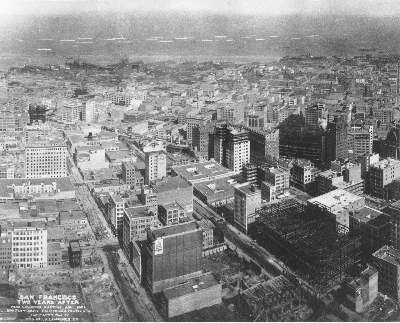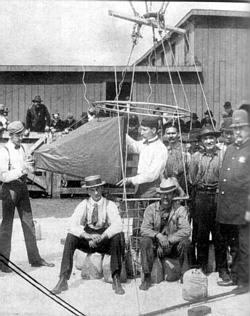By Simon Baker
 Detail of one of Lawrence's 1908 aerial photographs in which 27 white hulls of the Great White Fleet are visible. CHS |
In 1908, the airplane was still an experimental vehicle, and no one was yet doing serious aerial photography from the flimsy machines. Hydrogen-filled balloons were in use by some photographers, but Lawrence had tried them and, long before, rejected them as unsafe--with just cause. On 21 June 1901 Lawrence had what might have been a fatal accident while carrying out in a balloon an assignment to photograph the Chicago stockyards. He had completed shooting at an altitude of 900 feet and was being hauled down when, at 200 feet, the gas bag broke free of its retaining net. His fall was broken by a network of telephone and telegraph wires 30 feet above ground. From there he fell again, but was able to get up and walk away unhurt. 2 A second balloon mishap a month later in Minnesota seems to have convinced Lawrence that he should look for some other method of getting his cameras into the air.
 George R. Lawrence (standing inside the steadying mechanism) adopted as his business slogan, "The Hitherto Impossible in Photography Is Our Specialty." CHS |
Silas J. Conyne, a fellow Chicagoan, invented and patented a kite in 1902 for the purpose of raising aloft advertising banners to attract the attention of the public. Lawrence obtained the right to build Conyne kites and embarked on a period of experimentation to determine if and how they might be used to lift his cameras. He modified and improved well-known techniques for flying a train consisting of a series of kites attached by short lines to the main kite line. He was thus able to attain heights of up to 2,000 feet, lifting his large but relatively light panoramic cameras along with the piano wire cable used as the main kite line. Depending on wind velocity and the load to be lifted, Lawrence could fly as many as 17 kites in a train, although five to ten kites usually sufficed. From his successful aerial photographs it can be seen that Lawrence had devised effective means for holding his cameras steady while exposures were being made. A mount hanging suspended below the lowest kite in the train allowed the camera to be pointed and fixed in any direction before being sent aloft. Once in the air, a system of booms, lines, and lead weights prevented excessive horizontal turning while at the same time dampening the tendency of the camera to swing in the wind like a pendulum. He solved the problem of tripping the shutter by incorporating an insulated wire as part of the steel kite line and using it to carry an electric current up to the camera.
For purposes of aerial photography, Lawrence built his own cameras. To make very wide angle photographs, he modified an existing type of panoramic camera which had a curved film plane and a lens mounted in a horizontally rotating barrel on vertical pivots. He also modified flat plate cameras to function in a windy environment by replacing the leather bellows of each with a lightweight rigid box. In building his cameras, he used wood and aluminum throughout to reduce weight as much as possible. The lenses of his panoramic and flat plate cameras were mounted lower than the horizontal midlines of the film planes. This produced a high oblique aerial view showing more of the earth's surface and less of the sky, since the camera was usually level at the time of exposure.
In his panoramic cameras Lawrence modified the focal plane shutters to solve the problem of extremes of light encountered in high oblique aerial views. In order to reduce the usually abundant skylight and allow for a longer exposure of the darker land surface, he varied the width of the slit in the focal plane shutter. On entering the camera, the image reached the film upside down, so Lawrence made the slit wider on top to increase the length of exposure of the land surface while reducing the amount of skylight recorded.
By 1905, Lawrence had perfected his system for making aerial photographs, and his work came to the attention of President Theodore Roosevelt, who requested a demonstration for the military. A group of Army and Navy officers assembled at Indian Head, Maryland, in May 1905 to examine the apparatus and observe how Lawrence operated it. After the demonstration was completed, someone pointed out that the kites, camera, and stabilizing mechanism could not be launched and retrieved from the deck of a ship employing the methods Lawrence used on land. During a few days of experimentation, Lawrence attempted to launch the captive airship from the deck of a tugboat on the Potomac River. Results of this hurried effort were poor, but the reporting officer, Lieutenant L. H. Chandler, felt that Lawrence should be given an opportunity to make the necessary changes in the apparatus and try it out at sea. 3
The Navy was interested, so Lawrence went aboard the USS Maine on 25 August 1905 with his apparatus, two assistants, and his representative, patent lawyer Walter H. Chamberlin. They remained on board until 7 October, working under the scrutiny of a board of three officers: Lieutenant Commander W. H. G. Bullard, Lieutenant Commander A. L. Willard, and Lieutenant J. H. Holden. Among other things, the board noted how long it took from the launching of the first kite to the raising of the camera, making an exposure, and returning the camera to the deck. The officers timed two such exercises involving different cameras, and found that each effort took about an hour and a half. In its report, the board described the captive airship and its various parts and explained how it had been modified since the May demonstration for operation from the deck of a battleship. 4 The report also mentioned experiments in long-range photography with a flat plate camera having a 36-inch focal length lens.
Of considerable importance is a brief note in the report about the panoramic camera used by Lawrence. It was described as holding a plate 20 inches by 48 inches, having a focal length of 19 inches, and weighing 49 pounds. Virtually all the important aerial photographs taken by Lawrence in the next five years were approximately 20 inches by 48 inches in size and must have been taken by this very camera, or another of like dimensions and weight.
After observing Lawrence at work for more than a month, the board was of the opinion that
"The idea of taking photographs from high altitudes is under certain circumstances, especially during war, of inestimable value: such as locating ships in enclosed or blocked harbors, the interior of fortresses, the location of shore batteries, etc. The scheme worked out by Professor Lawrence both from a purely mechanical and photographic point of view is excellent, though the details of the actual working parts may be much improved. The scheme can be more effectively used on shore than on ship board where the working room is of necessity limited. It would not be practicable to use the apparatus on board a battleship with the ship's force to do the work, but that with practice, officers sufficiently acquainted with photography could soon become skillful in this kind of work." 5
The board recommended that Lawrence be invited to demonstrate the apparatus on board an auxiliary attached to the fleet after making further changes and improvements. In case this could not be arranged, the board suggested that the government secure the right to use the apparatus and perfect it. Apparently, neither of these recommendations was ever carried out. Lawrence was reported to have withdrawn his offer to sell the apparatus when he could not get his price. Thus ended the contact between Lawrence and the U.S. Navy. But the efforts of the Navy in examining the captive airship and describing it in the two excellent reports discussed above have provided us with the most accurate and detailed knowledge of the apparatus available.
| A Professor of Geography at East Carolina University (where he teaches courses in Aerial Photographic Interpretation and Remote Sensing), Dr. Baker is astonished every time he sees the huge aerial photographs of Lawrence. |
FOOTNOTES:
#1 Baker, Simon, "San Francisco in Ruins: The 1906 Aerial Photographs of George L. Lawrence," Landscape, vol. 30, no. 2 (1989):9-14.
#2 The Chicago Tribune, Saturday, 22 June 1901, p. 3.
#3 U.S. National Archives, Record Group 74, Report to the Chief of Bureau of Ordnance, U.S. Navy, by Lieutenant L. H. Chandler, 22 May 1905.
#4 U.S. National Archives, Record Group 74, Report to The Commander in Chief U.S. Atlantic Fleet by Lieutenant Commander W. H. G. Bullard, Lieutenant Commander A. L. Willard, and Lieutenant 1. H. Holden, 12 January 1906.
#5 Ibid.
SOURCE ABBREVIATIONS:
CHS: Chicago Historical Society
LOC: Library of Congress
NARA: National Archives
YANUL: Collection of Thomas Yanul